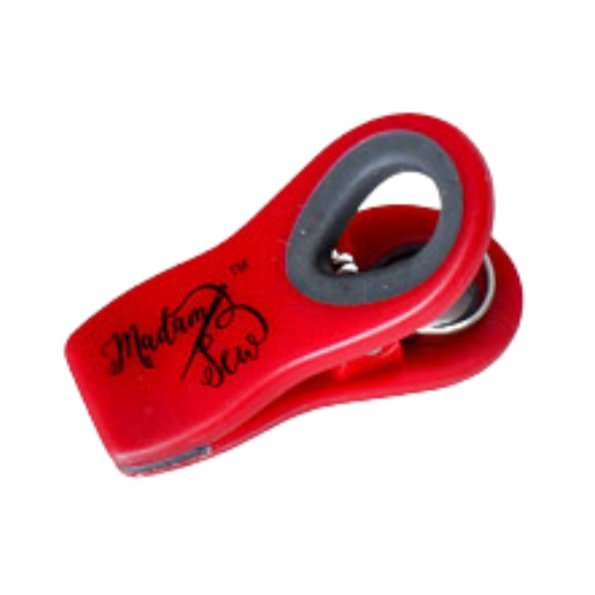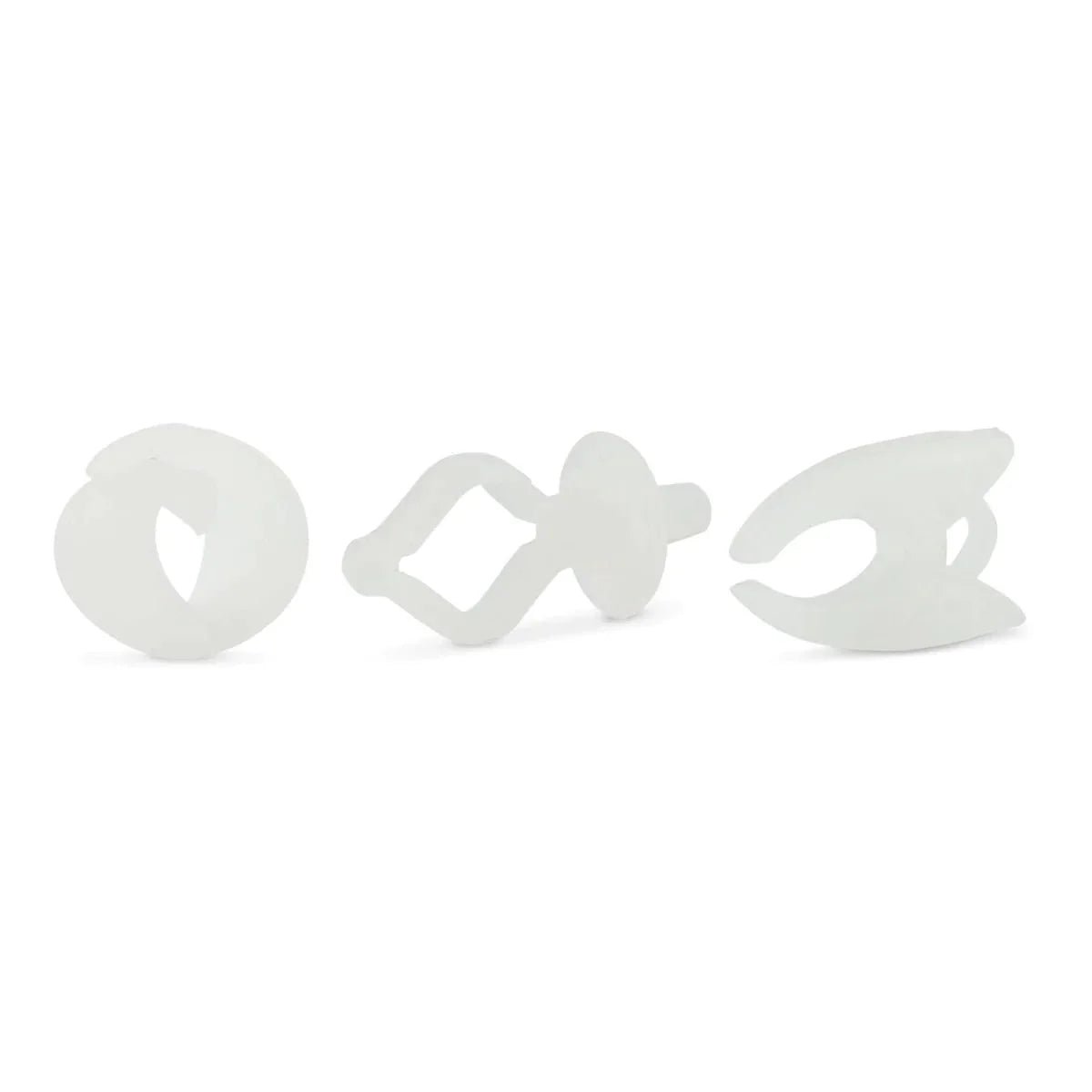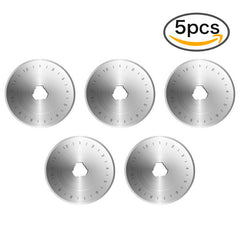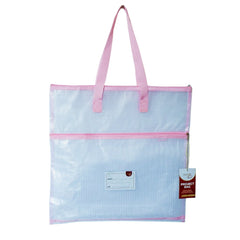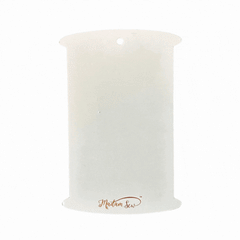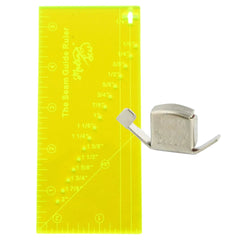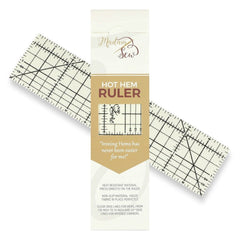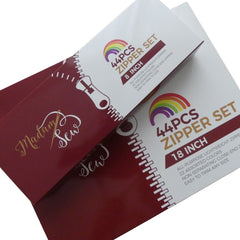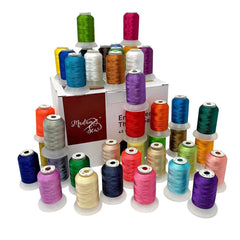How to Sew This Shoulder Bag with Recessed Zipper
Fun fact: October 10th is National Handbag Day! And what better way to celebrate than by sewing your own shoulder bag with a recessed zipper?
I know what you're thinking: "Recessed zipper? That sounds complicated!" But here's the thing it's actually not as tricky as it looks. Once you understand the technique, you'll be adding recessed zippers to everything. They give bags such a clean, professional finish, and you get the security of a zipper closure without any hardware showing on the outside.
This tutorial will show you exactly how to create a spacious, structured handbag (finished size: 12" × 18" × 3") with two 13-inch long shoulder straps and a zipper. I'll walk you through each step with detailed instructions, from preparing your fabric and creating the recessed zipper panel, to attaching sturdy straps and bringing everything together. I even included the fabric choices I made and why, so you can see the real-world decision-making process.
Whether you're making this for International Handbag Day or just because you need a fantastic new bag, let's get sewing!
Your finished tote will have a recessed zipper that's completely hidden from the outside, giving you a clean, sophisticated look with secure closure!
Materials Needed
You will need a sturdy fabric to make this bag. If you want good structure and durability, you can choose between many different fabrics. These are some good options: (waxed) canvas, heavy denim, cotton twill, outdoor, drapery or upholstery fabric. I would avoid stretch fabrics and pick woven medium to heavy weight fabrics.
For the lining you can use quilt cottons or any other cotton blend fabric or even linen. Choose smooth fabrics that don’t catch on items you put in the bag and consider a print to hide stains. Lighter colored fabrics help you see better inside the bag.
- 1 ¼ yards or 40 inches of main fabric (at least 40” wide) for the bag exterior.
- 1 ¼ yards or 40 inches of lining fabric (at least 40” wide)
- 1 ¼ yards or 40 inches of interfacing (at least 40” wide)
- 30 inches of batting to give the bag more volume. You can also use a foam stabilizer.
- 1/2 yard of fabric for the straps or ready-made straps/webbing
- 1/2 to 1 yard of fusible interfacing for the straps (no need if you use ready-made straps)
- 18" (or longer) nylon zipper or zipper tape by the yard (with zipper pull)
- Matching good quality sewing thread
For the outer fabric I picked a stiff fabric that I was going to use for jean-like trousers but I never started this project. The fabric has a waxy feel to it and it wrinkles easily, but I forgot what the fabric composition is. For the lining, I’m using a piece of Ikea curtain 100% cotton that was too long for my son’s bedroom. It is soft and drapey but sturdy enough.
To reinforce the fabric and give the bag some structure, first add fusible interfacing to the outer fabric layer. You can choose between many different types of interfacing. I used a non-stretch relatively firm fusible interfacing. I wanted to use up some scraps so on one side of the bag I did a little interfacing patchwork. You can then also add a foam stabilizer or batting to add structure and volume to the bag. If it is fusible you can just fuse it to the outer fabric, if not, you need to quilt them to the outer layer to make sure that extra layer stays in place. That is what I did.
Tools
The basic tools you need are:
- Sewing machine
- Zipper foot
- Fabric scissors
- Iron and ironing board
- Flower head pins or sewing clips
- Ruler or measuring tape
- Fabric marker
Optional tools that will make bag making easier and the results better looking:
- Walking foot to sew thick layers on a regular sewing machine without effort
- Bulky seam jumper to handle sewing over thick bulky seams
- Tube Turner Set to turn long tubes like the straps of this bag
- Sewist Magic Wand to guide your layers under the sewing machine more easily
Step-by-Step Instructions
Step 1 : Cutting Instructions
-
Main fabric:
- 2 rectangles 20" × 15" (bag panels)
- 2 rectangles 20" × 4" (zipper panels)
-
Lining fabric:
- 2 rectangles 20" × 15" (bag panels)
- 2 rectangles 20" × 4" (zipper panels)
-
Strap fabric: 2 strips 4" × 57"
-
Fusible interfacing:
- 2 rectangles 20" × 15" (bag panels)
- 2 rectangles 20" × 4" (zipper panels)
- Optional: 2 strips 4" × 57" (straps)
- Batting: 2 rectangles 20 x 15”
Step 2 : Attach Interfacing and your Preferred Stabilizer
Following manufacturer's instructions, fuse or baste the interfacing to the wrong side of each of the two main fabric rectangle and the two main fabric zipper panels. This thickens the fabric, adds weight and makes it sturdier and more durable.
To add structure, add foam stabilizer or batting. If you are using batting or non-fusible stabilizer, you can either glue it to the main fabric pieces or quilt it in place with parallel straight lines or wavy lines.
I quilted the batting to the outer fabric rectangles. If this is all new to you, I would advise to
- draw a help line in the center of the fabric with an erasable marking pen.
- pin the outer fabric to the batting with long flower head pins
- use a walking foot with a guide on your machine,
- start stitching the two layers together sewing parallel lines. Always start with the line in the center and work outward toward the edges, using the guide of the walking foot or marks to keep a consistent distance between the lines.
✄⚉
🚩Part 1: The Recessed Zipper Part
Step 3: Prepare Zipper Panels
Take your four zipper panel rectangles (2 main fabric, 2 lining).
- At the bottom corners of all four panels, draw a ¾" square at each corner with a fabric marker.
- Cut out these two squares per panel.
You now have four panels with notched corners - the zipper will be sewn along the edge with the cut-out squares.
With a 4-inch width, this recessed zipper will sit about 2 inches deep from the top edge of the bag. If you feel this is too deep, you can make the zipper panels 3 inches wide.
Step 4: Attach Zipper to First Set of Panels
1. Lay one main zipper panel right side up with the notched edge facing away from you.
2. Place the zipper face down on top, aligning it along the upper edge between the notched corners.
3. Now place one lining panel face down on top, sandwiching the zipper in the middle. Use sewing clips to secure the fabrics. Make sure all four notched corners align at both ends.
4. Using a zipper foot, sew through all three layers (main, zipper, lining) at 3/8" from the zipper coil.
❗Sewing TIP: Depending on the bulk of the fabric, you might sometimes have trouble feeding the layers under the presser foot that is attached to your machine without getting puckers. Grab a sewing stiletto like Madam Sew’s Magic Wand to guide the fabric more smoothly.
5. Press the seams away from the zipper. Don’t iron on the zipper coil.
6. Repeat the same process for the other two (main and lining) zipper pieces on the opposite zipper tape.
This is what the zipper piece should look like now:
Step 5: Topstitch Next to the Zipper
Topstitch close to the folded edge on both sides of the zipper using a zipper foot.
If you are using zipper tape by the yard, now is the time to attach the zipper pull, if you haven’t already.
Step 6: Close the Zipper Panel Ends
1. Cut off any excess zipper tape. You should see the shape of the cutouts clearly at both ends.
2. At one end, bring main panels right sides together and lining panels right sides together. Pin or clip these short ends together.
3. Sew across the short ends with a ⅜" seam allowance, backstitching at the beginning and end
4. Repeat for the other end.
Step 7: Create Boxed Corners
1. Make sure the zipper pull is centered.
2. With main fabric facing up, bring one sewn seam toward the zipper to form a triangle. Open the seam flat and center it over the middle of the zipper teeth. Flip to the lining side and do the same - form a triangle with the seam centered over the zipper.
3. Pin or clip where the raw edges meet at the peak of the triangle.
4. Sew along the straight edge formed by the notched corners with a ¾ inch seam allowance. You'll be sewing through 4 fabric layers and the zipper - go slowly. The length of the row you are sewing is about 2 ½ inches.
5. Repeat for the other end.
6. Trim excess seam allowance to reduce bulk.
Turn the finished zipper panel so main fabric is inside and lining is outside. It should look like a "zipper boat" with boxed ends. Set aside for now.
✄⚉
🚩Part 2: The Straps
Step 8: Make the Straps
1. Apply fusible interfacing to the center of each strap piece on the wrong side if your strap fabric needs additional structure.
2. The fastest way is to fold each strap in half lengthwise, right sides together and sew close to the long edge. To turn a long strap like this right side out you need a tool like the Madam Sew Tube Turner Set. Another way of sewing a long strap is ironing the long edges inwards at ½ inch and topstitch along both edges to close the strip and hide the raw edges.
3. Press with the seam centered on one side.
4. Topstitch ⅛" from each long edge to finish the straps.
Step 9: Attach Straps to Bag Body
1. For strap placement, grab a marker and measure 5 inches from the side of the outer bag panel. Mark at the bottom and top edge. Pin straps aligning the outside of the strap with these marks. The raw edges of the strap are even with the bag’s bottom edge. The strap makes a closed loop at the top edge.
2. Sew through both the strap and the main bag panel, following the topstitching lines from step 8. I’m using my walking foot again to handle these layers more easily. Start at the bottom of one strap and work your way up.
Don’t sew all the way to the raw edge. Stop 1 inch from the edge, needle down, turn 90 degrees, sew across the strap until the topstitching of the other edge, stop with needle down, turn 90 degrees and sew on the topstitching until the bottom edge of the bag. Repeat for the other strap on the same panel.
3. Repeat these steps for the other panel and strap.
When using a walking foot, you can’t backstitch so leave the thread ends a little longer, pull them to the wrong side of the fabric and knot. And don’t forget to cut the many thread ends away so they don’t get in the way of your stitching.
✄⚉
🚩Part 3: Assemble the Main Bag
Step 10: Sew Main Bag Sides and Bottom
1. Place main bag body pieces right sides together. Use pins or clips to match the edges.
2. Sew the side seams and bottom seam with ½ " seam allowance (or up to ⅝” if it’s hard to align your different layers properly). Leave the top open - this is where the zipper panel will be inserted.
3. Trim the edges a little if necessary to remove bulk.
Step 11: Create Bottom Corners
1. At each bottom corner, bring the side seam to meet the bottom seam.
2. Measure 2" from the point along the seam line. Draw a line perpendicular to the seam at this point.
3. Sew along this line to create a boxed corner.
4. Trim excess fabric to 1/2".
✄⚉
🚩Part 4: Assemble the Lining
Step 12: Prepare Lining
Repeat steps 10 and 11 with the lining pieces, but leave a 6" opening in the bottom seam for turning. Use the same seam allowance as you used for the main panels in step 10. You don’t want the lining to be too big for the bag.
Step 13: Attach the Recessed Zipper
If you feel that the recessed zipper sits too deep, you can trim the zipper panels in this step.
1. Turn the lining bag wrong side out. The recessed zipper part should also be facing right side out (with lining fabric facing right side out). Keep the zipper open.
1. Insert the recessed zipper part into the lining bag and match the seams and the raw edges. Clip or pin together.
2. Sew all around with ½ inch seam allowance. Trim the edges.
✄⚉
🚩Part 5: Final Assembly of the Lining and the Bag
Step 14: Sew Zippered Lining to the Handbag
1. Turn the main bag right side out. Keep the lining wrong side out. Open the recessed zipper completely.
2. Insert the main bag into the lining through the zipper (they should be right sides together). Make sure the straps (handles) are tucked in nicely so they don’t get caught into the seam.
3. Pin all around, matching raw edges and side seams to the zipper panel side seams.
4. Sew all around the top with a ½" seam allowance. Sew on the stitching from step 13 or just next to it, a little farther from the raw edge, so you don’t see this stitching. Take your time and sew slowly where the side seams meet. If it is too bulky for your machine, use a walking foot and a bulky seam jumper.
Step 15: Finish the Handbag
1. Turn the entire bag right side out through the opening in the lining bottom.
2. Push the lining down into the bag.
3. Close the opening in the lining bottom with a ladder stitch by hand or a topstitching with your machine. Fold the raw edges inward, pin the fabric together and sew close to the edge.
4. Press the top edge of the bag, and add topstitching ¼ to ⅜ inch from the edge to keep the recessed part in place. Again, I used my walking foot to handle the bulky layers and maneuver along the handles.
And this is it, this bag is ready to be used! I’m really happy with the result and the size of this bag. It is comfortable, holds a lot of stuff, protects the contents well and matches with most of my clothes and jackets.
Some Extra Tips for Success
- Use a sharp needle (change to a new one if you are already using the same needle for a while). Sewing through multiple layers and the zipper tape, calls for good material!
- Go slowly when sewing over zipper teeth
- Press as you go and press seams open when possible to reduce bulk
- Use enough pins or clips to hold everything in place before and when you sew.
- Cut off thread ends off regularly.
⭐Conclusion
You did it! Your brand new handbag with a secret hidden zipper is complete, and I hope it looks absolutely amazing. Take a good look at it. You made that! And maybe you did it on National Handbag Day!
I hope this tutorial showed you that recessed zippers aren't as scary as they seem. Yes, there are several steps, and yes, you need to pay attention to those notched corners and seam allowances. But break it down step by step, and suddenly you've got this neat-looking bag that you made with your own two hands.
Now you know how to do this. Next time you need a bag you've got this technique in your back pocket. You can make shoulder bags, tote bags, or cosmetic bags, for yourself, for a gift, for selling at a craft fair.
Show Off Your Work!
I'd absolutely love to see your finished bag! Share it on Instagram or Facebook and tag @MadamSew #MadamSew so I can admire your work. There's something special about seeing what you all create from these tutorials. Plus, you might inspire someone else who's been nervous about trying to make a bag or add a recessed zipper to finally give it a go.
Thank you for sewing along with me, and I hope you love your new bag as much as I know you will. Here's to many more handmade projects and to celebrating National Handbag Day in style!
Happy sewing!
An
Blogging for MadamSew.com
Click here for the free download of this “handbag with a recessed zipper” tutorial







